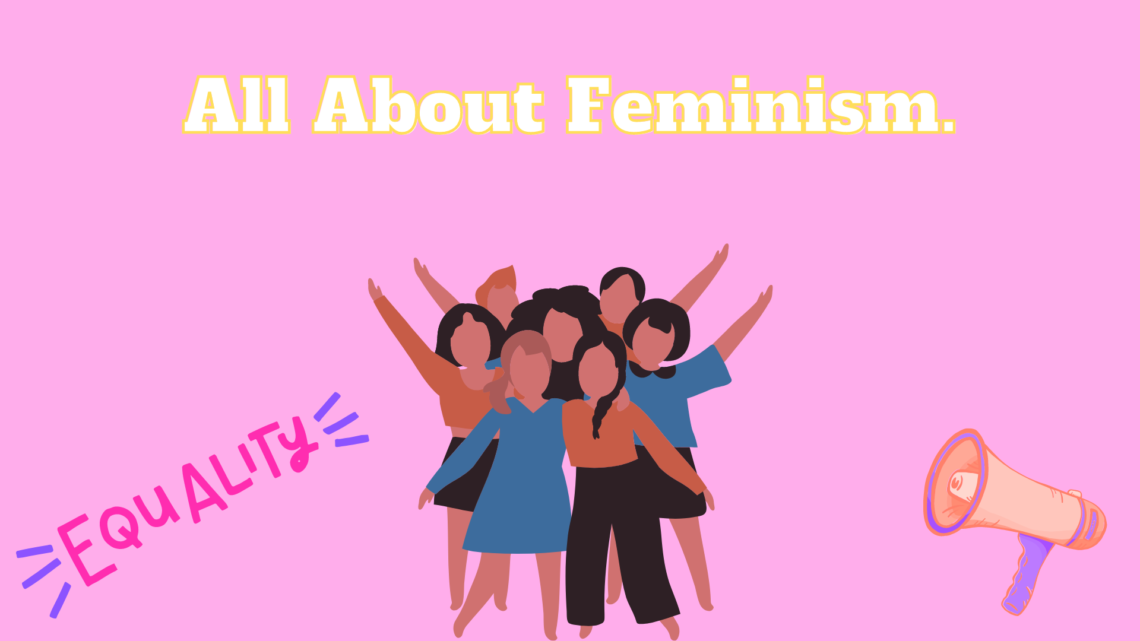
All About Feminism.
Feminism
To understand Feminism, we first have to unlearn that it came with the Me-Too-Movement movement. No, Feminism did not emerge with the Me-Too Movement. Feminism is the belief that men and women should have equal rights, opportunities, dignity, and humanity. Feminism is the Equality of social, political, and economic development for men and women.
Feminist activism is also an end to sexism, sexual exploitation, and oppression. We live in a patriarchal society with sexist ideologies, i.e., where men hold more power than women and women are inferior to men.
Due to social media, bad feminism has also emerged, resulting in misandry, i.e., hating men, and misogyny, i.e., hating women. Bad feminism is that women, even realizing their full rights, are inferior or superior to men. Bad feminism allows people to hate all men or women in the name of the Right to Equality and justice. Men and boys indeed exercise more rights than women. Still, it is also true that bad feminism is not allowing men to exercise their existing rights.
Being a feminist is believing in Equality of all genders.
Pseudo Feminism
Pseudo feminism is the ideology that women are superior to men and that they deserve more respect than men. It tarnishes the meaning of true Feminism. Pseudo feminism revolved around resolving injustices towards women by attacking, demeaning, or not letting men exercise their rights. It also believes that if men speak out about injustice they face, they are lying. Pseudo feminism is bad feminism as it does not ensure equal rights and justice for all genders is partial towards women and is against men.
Radical Feminism
Radical feminism views society as a patriarchal one, one that oppresses women. Radical feminists challenge social norms and institutions to liberate everyone from a patriarchal society. The movement includes opposing the sexual objectification of women and awareness of rape and violence against women. They also challenge the ideology of having gender roles. They argue that genital differences should not matter culturally or politically. While also maintaining to recognize women’s role in reproduction and that they shouldn’t have to receive a penalty in the workplace. Radical feminists also argue that women, as well as non-dominant men, should be free from oppression.
The Four Waves of the Feminist Movement
Now that we have learned the vocabulary around Feminism let’s talk about how Feminism emerged.
One of the oldest movements in global history is Feminism. As time went by, specific goals were created, forming many types of Feminism, which are divided into “waves” to outline the story of the messy and complex feminist movement.
The First Wave
Feminism appeared in the late 1790s. Mary Wollstonecraft wrote and published two editions of ‘A Vindication of the Rights of Woman in 1792. Two hundred women met in a church to discuss resolutions for specific rights, including the right to vote, in 1848. And after years of small feminist movements, in 1920, Congress passed the 19th amendment and gave women the right to vote in the USA, 30 years after New Zealand became the first country where women voted. The first wave of Feminism had a simple goal, i.e., for society to recognize women as humans and are not functional or property.
In India, social reform movements appeared. Raja Ram Mohan Roy argued against sati, polygamy, and property rights for women. Native Marriage Act, which forbade marriage between girls under 14 and boys under 18, was passed in 1872. Forbade Polygamy allowed inter-caste and widow marriages. National organizations follow the formation of Regional organizations to improve the civil, moral, and educational rights of women and children.
The Second Wave
In the 1960s and 1970s, a second wave challenged women’s societal role. Activists took a close look at the oppression of women and questioned the traditional gender and family roles of women. Major victories of the second wave were the Equal Pay Act of 1963, Roe v. Wade in 1973, and a few other supreme court cases in the USA.
In India, between 1917 and 1927, women’s formation of WIA, NCWI, AND AIWC discussed women’s empowerment. Women were fighting two wars, one against the colonial role and the other against patriarchy in their homes. women joined the non-violent civil disobedience movement. Women-only organizations were formed in various parts of the country to address problems like blockage acceptance of female education.
Mainstream/liberal, radical and cultural types of Feminism emerged during the second wave.
The Third Wave
After the second wave victories, women enjoyed more rights and power in the 1990s. Many women freely expressed their sexuality, and fashion changed. One rule that emerged in the third wave was there were no rules for women. Women began to choose how wanted to live their life.
Intersectionality, Kimberlee Crenshaw coined this phrase in 1989. It referred to different kinds of oppression based on gender and race and how they intersected with each other. Racial disparities ignored by first and second-wave Feminism came to light: Rebecca Walker, a 23-year-old Black bisexual woman, coined the phrase third-wave Feminism in 1992. And then, the internet made it easier for feminists to be heard.
In India, The Marriage Act of 1954 and the Hindu discussed marriage, divorce, succession, guardianship and adoption, legal monogamy, and outlawing polygamy among Hindus. And equal divorce rights for men and women inter-caste and interreligious marriages are legal. It fixed the marriage age for girls and boys. It also made child marriage punishable.
The Hindu Succession Act, 1956, The Hindu Minority and Guardianship Act, 1956, The Dowry Prohibition Act, 1961, and The Maternity Benefits Act, 1961 were some other acts during this period. The NFIW (National Federation of Indian Women) was established in 1954 to work for the empowerment of women and women’s.
In 1973, the Progressive Organization of Women was formed. They took up issues like anti-dowry campaigns, protests against eve-teasing (the harassment of women in the street), obscenity, price rise, and the hardships of women’s lives in slums. Common issues are a division of housework, rape, and dowry deaths.
NCW, the national commission for women, was formed on 31st January 1992. The welfare-oriented approach shifted to women’s development and empowerment in consecutive five-year plans. Five-year plans changed their course each year, focusing on better implementation of welfare schemes. Priority to women’s education, improvement in maternal and child health services, nursing, and employment improved—the promotion of women’s economic and social status and beneficiary-oriented programs which provided direct benefits to women. Gender studies were also got introduced in the 20th century, and all aspects of women’s health, education, and employment saw record growth. Government-provided welfare schemes for single women recognized women in the minority castes and provided separate plans for them.
The Fourth Wave
With the Me-Too-Movement movement and resurgence of attacks on women’s rights, we have entered the fourth wave of the feminist movement. The third wave’s emphasis on the inclusivity of women set the scene for social media activism in the fourth wave.
And women empowerment, gender equality, and freedom became central ideas of discussion. LGBTQIA rights became a vital part of the conversation. Inclusion of rights and growth of all genders are being promoted and emphasized in the fourth wave of Feminism.
What’s the Next Big Thing in Feminism?
You can observe that periods of waves were different for India and USA. Every country and the women of the country were growing at their own pace, also learning from each other.
For the next big thing in Feminism, in the fourth wave, many feminists believe that there is a need to address the intersectionality issues, especially in the face of climate change. During the pandemic, women and LGBTQIA lives saw a significant impact. Women of different races and ethnicities still struggle to make their voices heard in other parts of the world.
For the next big thing in Feminism, more robust social and cultural reforms should take place to ensure that all communities enjoy rights equally. Feminism began to focus on LGBTQIA rights and the rights of women and men belonging to different communities, races, religions, and ethnicities, especially on the rights of people with the least privileges in our society.
Equal opportunities in the career sector for all genders are needed to be emphasized strongly. From reproductive health care to political roles, voices of all gender identities, men, women, lesbians, Gay, Trans, Bisexual, Queer, intersex, and asexual, must be equally heard.
The belief that the Right to Equality is a problem of only a particular section of people needs to be unlearned. Right to Equality is an issue every person faces equally.
The next big thing in Feminism is to hear every person’s voice equally, irrespective of their gender identity or racial background. And to ensure everyone holds an equal position socially, economically, legally, and culturally in our society.




